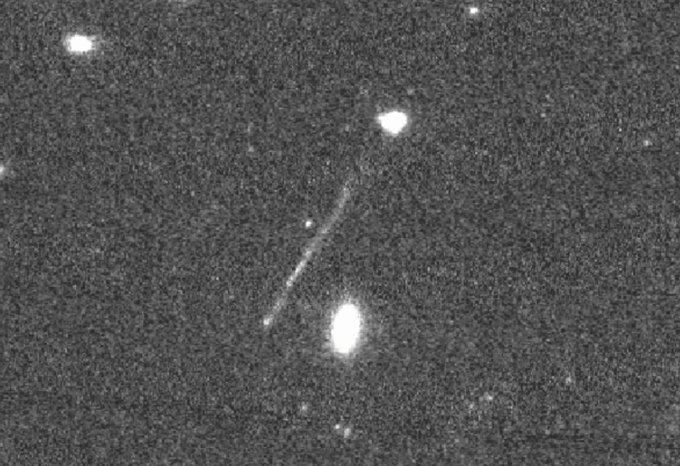This post was originally published on this site
A streak of light stretching away from a remote galaxy might be the first sure sign of a gargantuan black hole on the run, a new study reports. The putative black hole, fleeing its host galaxy, appears to be leaving a trail of newborn stars and shocked gas in its wake. If confirmed, the intergalactic escape could help astronomers learn more about what happens to black holes when galaxies collide.
“It’s a very cool, serendipitous discovery,” says astronomer Charlotte Angus of the University of Copenhagen, who was not involved in the new work. “The possibility that this might be due to a supermassive black hole that’s been ejected from its galaxy is very exciting. These events have been predicted by theory, but up until now, there’s been little evidence for them.”
While looking for colliding dwarf galaxies with the Hubble Space Telescope, astronomer Pieter van Dokkum and colleagues spotted something peculiar: a long, straight line that seemed to extend away from a distant galaxy, growing narrower and brighter as it went (SN: 5/18/22).
“Whatever it is, we haven’t seen it before,” says van Dokkum, of Yale University. “Most astronomical objects are shaped like a spiral or a blob. There are not many objects that are just a line in the sky.” When astronomers do see lines, they’re usually from something moving, like a satellite crossing the telescope’s field of view (SN: 3/3/23).
To figure out what it was, van Dokkum and colleagues took follow-up observations with the Keck Observatory in Hawaii. Those observations showed that the streak was associated with a galaxy whose light took about 8 billion years — more than half the age of the universe — to get to Earth, the team reports in a paper submitted February 9 to arXiv.org. The distance measurement let the team calculate the length of the line: roughly 200,000 light-years.
That certainly ruled out a satellite.
“We considered a lot of explanations, and the one that fit the best is what we’re witnessing is a massive object, like a black hole, moving very rapidly away from the galaxy,” van Dokkum says.

Black holes on their own are invisible. But “if a black hole leaves a galaxy, it doesn’t leave by itself,” van Dokkum says. Some of the stars and gas that were gravitationally bound to the black hole leave with it. That gas will emit strong radiation that telescopes can detect. The black hole’s path through the gas and dust in the galaxy’s outer regions can compress some of that gas into new stars, too, which would also be visible (SN: 7/12/18).
Another possibility is that the line is a jet of radiation launched by the galaxy’s central supermassive black hole. But that scenario would probably lead to a beam that is narrow when it is close to the galaxy and broadens as it gets farther away. This streak does the opposite.
If it’s a black hole, it could have been ejected from the galaxy’s center by interacting with one or two other black holes nearby. Almost every galaxy has a supermassive black hole at its center. When galaxies merge, their central black holes also eventually merge (SN: 3/5/21). If the conditions are right, that merger can give the resulting black hole a “kick,” sending it flying away at high speed (SN: 4/25/22).
Alternatively, the black hole could have been spat out of a smashup among three galaxies. When a third galaxy joins an ongoing merger, three supermassive black holes jockey for position. One black hole can be tossed out of the galactic smashup, while the other two take off more slowly in the other direction.
That’s what van Dokkum thinks happened in this case. There are signs of a shorter, dimmer streak heading in the opposite direction from the bright, straight line.
More observations of this system, perhaps with the James Webb Space Telescope, are needed to confirm that it really is an ejected supermassive black hole, Angus says. More theoretical calculations of what a runaway supermassive black hole should look like would help too.
The finding motivates Angus to search through archived data for more potential black hole streaks. “I wonder if there are more of these features out there, sitting in someone’s data that might have just been missed,” she says.
Van Dokkum does too. “Now that we know what to look for, these very thin streaks, it makes sense to go back to Hubble data. We have 25 years of Hubble images that have not been searched with this purpose,” he says. “If there are more to be found, I think we can do it.”
